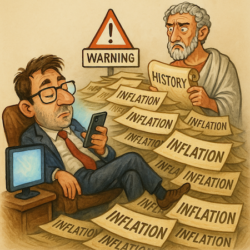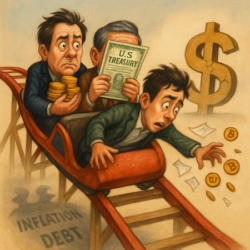 Publisher’s Note: It’s tempting to read today’s essay as a warning about U.S. markets. After all, it mentions Buffett’s growing cash position, AI volatility, and the echoes of past bubbles. But the point isn’t to frighten you out of American stocks. Far from it.
Publisher’s Note: It’s tempting to read today’s essay as a warning about U.S. markets. After all, it mentions Buffett’s growing cash position, AI volatility, and the echoes of past bubbles. But the point isn’t to frighten you out of American stocks. Far from it.
The U.S. market remains home to some of the most innovative, resilient, and profitable companies in the world. For many investors, it will continue to be a core source of long-term growth.
What this essay highlights is something much simpler and far more useful:
Even the strongest markets move in cycles. And understanding those cycles helps you invest with more confidence, not less.
Buffett raising cash doesn’t mean “sell everything.” AI volatility doesn’t mean “avoid technology.” And past bubbles don’t mean today’s opportunities aren’t real.
What it does mean is this:
Periods of rapid gains are usually followed by periods of digestion. Some areas of the market cool down while others begin to emerge. And investors who recognise these transitions early tend to make the most of them.
Warren Buffett, as far as we know, is not a regular reader of these posts. But in the news is word that Warren Buffett is pulling out of stocks, The Economic Times:
‘Warren Buffett’s Berkshire Hathaway cash pile hits record $381.7 billion — the biggest corporate war chest in U.S. history.’
That’s an increase of about $200 billion more cash in the last three years. Today, Berkshire has about a third of its money in cash. That is to say, it is ‘long stocks’ on only two thirds of its portfolio. Asked why he has so much cash, Buffett explained:
‘We’d love to spend it [cash], but we won’t spend it unless we think we’re doing something that has very little risk and can make us a lot of money. We only swing at pitches we like. It isn’t like I’ve got a hunger strike or something like that going on. It’s just that things aren’t attractive.’
What? Has the poor geezer never heard of AI? Didn’t he know that Friday was a great time to ‘buy the dip?’
Came this headline early Friday morning. Fast Company:
Hot tech stocks are tumbling: Why Tesla, Palantir, Nvidia, and others are leading a market sell-off today
The Wall Street Journal piled on…
Investors Dump Tech Shares as Shutdown Relief Evaporates
But wait. The press had jumped the gun. The Wall Street Journal describes what happened next:
After the opening bell rang in New York Friday, shares in Nvidia, Oracle and other companies at the heart of the artificial-intelligence boom careened low enough to flash a green light for dip-buyers. Stocks quickly pared much of their losses, clawing back enough ground for major indexes to finish the week mixed.
Yes, the dip buyers saved the day.
What to do? Buy the dip? Or get out? There are a lot of people who believe you should stay fully invested in stocks all the time.
One of them is our old friend Alex Green, who has just written an ambitious new book explaining why. In short, Alex thinks ‘the American Dream’ is still very much alive…and he believes a new Golden Age for investors is ahead. Who knows?
But if there is a golden age coming, it will probably have to climb over the corpses of a lot of dip buyers. The AI-centered bubble has become so absurd that Dan and Tom are now recommending…no, they’re ‘suggesting’ or perhaps just ‘toying with the idea’…of taking a way out-of-the-money short position. The odds of making money on it are slim; but wouldn’t it be fun!
Since AI is so smart, let’s put the question to it. Stay in AI stocks? Buy the dips? Or get out while the gettin’ is good?
Here’s the Grok 4 reply:
Is This the End of the AI Bubble?
It’s too early to call it “the end,” but there are bubble-like characteristics worth noting:
- Bubble Signs: Valuations have been sky-high—NVIDIA’s P/E ratio hit over 70 at points, reminiscent of the dot-com era. The AI boom has been driven by massive hype around generative AI (like ChatGPT and Grok), but actual monetization is still ramping up. If earnings disappoint or if AI adoption slows, we could see more downside.
- Counterarguments: AI isn’t just hype; it’s transformative tech with real applications in everything from healthcare to autonomous vehicles. Companies like xAI (my creators) and others are pushing boundaries, and long-term demand for AI infrastructure (chips, data centers) remains strong. Analysts from firms like Goldman Sachs have noted that while a correction is healthy, the AI sector could still grow exponentially—potentially adding trillions to global GDP.
- Historical Parallels: Think of the internet bubble in the late ‘90s—lots of froth, a big pop, but the survivors (Amazon, Google) became giants. AI might follow a similar path.
A very reasonable reply. But still blah blah. Grok 4 doesn’t know any more than we do.
Warren Buffett doesn’t bother with it. Stock prices are ‘mean reverting,’ which is to say that they always go back to a ‘normal’ range. And when they are extremely overvalued as they are today, they have a lot of ground to cover (losses!) to get back where they ought to be.
Just look at what happened to the leading stocks of the dot-com bubble. Corning, JDS Uniphase, Lucent, Nortel, Ciena, Global Crossing, Level Three — all got whacked hard; many never recovered.
As for an investor, the problem is always the same. The old timers on Wall Street say, ‘you make your money when you buy.’ And this looks like a bad time to buy AI stocks.
Buffett is cutting back on Berkshire’s large holding of the high-tech darling, Apple. He began buying the stock less than ten years ago, when he could get it at a P/E ratio of just 10. Today, the P/E is up to 36. At 10, Apple was a good buy. At 36 it is a good sell.
That is the problem for the market as a whole. It recently rose to a CAPE ratio (cyclically adjusted P/E) near 40. It’s only done that once before — in 1999.
Hey AI…how did that work out?
Best,
![]()
Bill Bonner
Contributing Editor, Investor’s Daily



